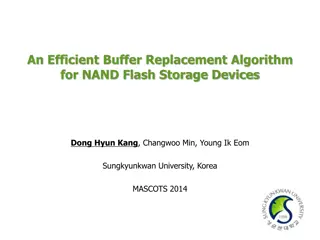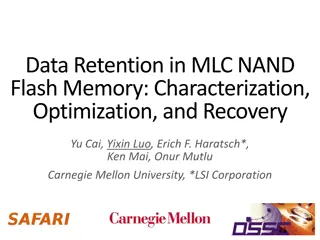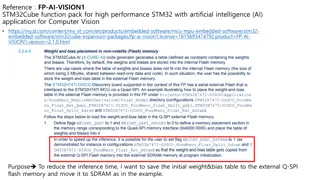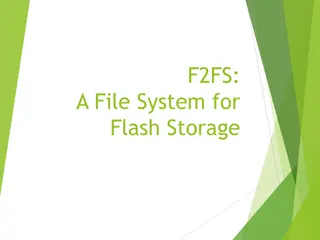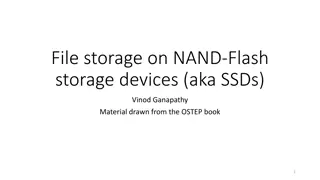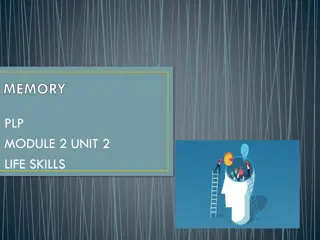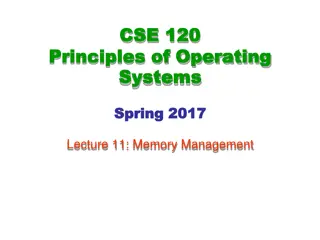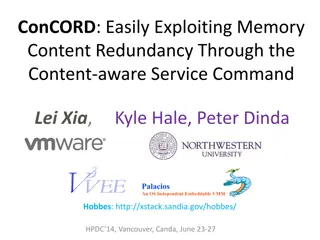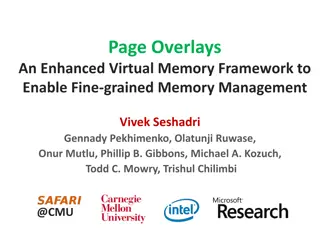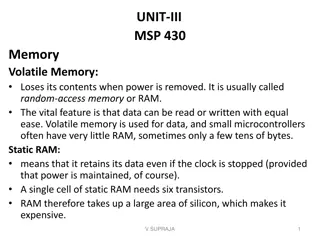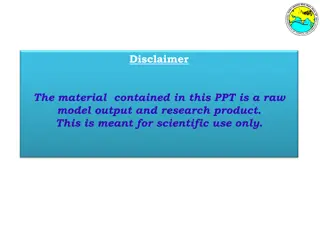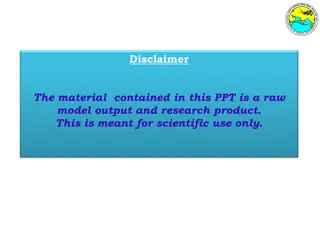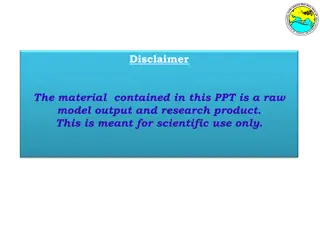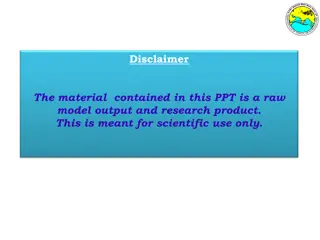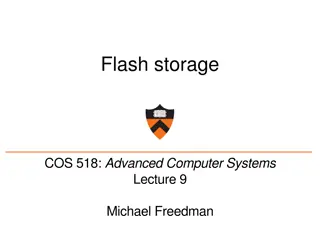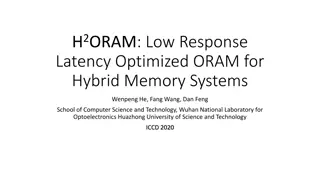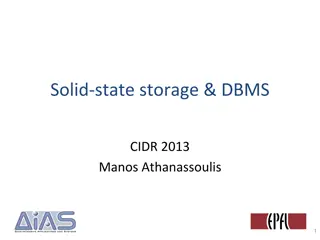Enhancing NAND Flash Memory Lifetime with Write-Hotness Aware Retention Management
Flash memory endurance can be significantly improved by implementing Write-Hotness Aware Retention Management (WARM) strategies, such as physically partitioning write-hot and write-cold pages and applying different policies to each group. This approach reduces the need for unnecessary refresh operations, leading to a substantial increase in flash memory lifetime. By implementing WARM without refresh, lifetime improvements of 3.24x can be achieved, and with adaptive refresh, improvements of 12.9x are possible, surpassing the benefits of refresh-only methods. Retention time relaxation is crucial for optimizing flash memory endurance, with the potential to extend operational lifespans and minimize unusable endurance caused by refresh operations.
Download Presentation

Please find below an Image/Link to download the presentation.
The content on the website is provided AS IS for your information and personal use only. It may not be sold, licensed, or shared on other websites without obtaining consent from the author. Download presentation by click this link. If you encounter any issues during the download, it is possible that the publisher has removed the file from their server.
E N D
Presentation Transcript
WARM Improving NAND Flash Memory Lifetime with Write-hotness Aware Retention Management Yixin Luo, Yu Cai, Saugata Ghose, Jongmoo Choi*, Onur Mutlu Carnegie Mellon University, *Dankook University 1
Executive Summary Flash memory can achieve 50x endurance improvement by relaxing retention time using refresh[Cai+ ICCD 12] Problem: Refreshconsumes the majority of endurance improvement Goal: Reduce refresh overhead to increase flash memory lifetime Key Observation: Refresh is unnecessary for write-hot data Key Ideas of Write-hotness Aware Retention Management (WARM) Physically partition write-hot pages and write-cold pages within the flash drive Apply different policies (garbage collection, wear-leveling, refresh) to each group Key Results WARM w/o refresh improves lifetime by 3.24x WARM w/ adaptive refresh improves lifetime by 12.9x (1.21x over refresh only) 2
Outline Problem and Goal Problem and Goal Key Observations Key Observations WARM: Write WARM: Write- -hotness Aware Retention Management hotness Aware Retention Management Results Results Conclusion Conclusion 3
Outline Problem and Goal Problem and Goal Key Observations Key Observations WARM: Write WARM: Write- -hotness Aware Retention Management hotness Aware Retention Management Results Results Conclusion Conclusion 4
Retention Time Relaxation for Flash Memory Flash memory has limited write endurance Retention timesignificantly affects endurance The duration for which flash memory correctly holds data Retention Time Typical flash retention guarantee 3-year 3000 3-month 8000 Requires refresh to reach this 3-week 20000 3-day 150000 0 50K 100K 150K Endurance (P/E Cycles) [Cai+ ICCD 12] 5
NAND Flash Refresh Flash Correct and Refresh (FCR), Adaptive Rate FCR (ARFCR) [Cai+ ICCD 12] 150000 3000 Extended endurance Unusable endurance (consumed by refresh) Nominal endurance Problem: Flash refresh operations reduce extended lifetime Goal: Reduce refresh overhead, improve flash lifetime 6
Outline Problem and Goal Problem and Goal Key Observations Key Observations WARM: Write WARM: Write- -hotness Aware Retention Management hotness Aware Retention Management Results Results Conclusion Conclusion 7
Observation 1: Refresh Overhead is High 100% % of Extended Endurance 90% Consumed by Refresh 80% 70% 60% 53% 50% 40% 30% 20% 10% 0% 8
Observation 2: Write-Hot Pages Can Skip Refresh Update Retention Effect Write-Hot Page Write-Hot Page Invalid Page Write-Cold Page Write-Cold Page Write-Cold Page Write-Cold Page Invalid Page Write-Cold Page Write-Hot Page Write-Hot Page Invalid Page Write-Hot Page Write-Hot Page Skip Refresh Need Refresh 9
Conventional Write-Hotness Oblivious Management Flash Memory Hot Page 1 Cold Page 2 Hot Page 1 Cold Page 3 Hot Page 4 Cold Page 5 Page 256 Hot Page 1 Page M Read Page 0 Page 257 Hot Page 4 Cold Page 2 Cold Page 3 Cold Page 4 Page M+1 Write Erase Page 1 Page 2 Page 258 Page M+2 Page 255 Hot Page 4 Page 511 Page M+255 Unable to relax retention time for blocks with write-hot and cold pages Flash Controller 10
Key Idea: Write-Hotness Aware Management Flash Memory Hot Page 1 Hot Page 1 Hot Page 4 Hot Page 4 Hot Page 1 Hot Page 4 Hot Page 4 Hot Page 1 Page 256 Cold Page 2 Page 0 Page M Page 257 Cold Page 3 Cold Page 5 Page 1 Page M+1 Page 2 Page 258 Page M+2 Page 255 Hot Page 1 Page 511 Page M+255 Can relax retention time for blocks with write-hot pages only Flash Controller 11
Outline Problem and Goal Problem and Goal Key Observations Key Observations WARM: Write WARM: Write- -hotness Aware Retention Management hotness Aware Retention Management Results Results Conclusion Conclusion 12
WARM Overview Design Goal: Relax retention time w/o refresh for write-hot data only WARM: Write-hotness Aware Retention Management Write-hot/write-cold data partitioning algorithm Write-hotness aware flash policies Partition write-hot and write-cold data into separate blocks Skip refreshes for write-hot blocks More efficient garbage collection and wear-leveling 13
Write-Hot/Write-Cold Data Partitioning Algorithm Cold Virtual Queue TAIL HEAD Cold Data 1. Initially, all data is cold and is stored in the cold virtual queue. 14
Write-Hot/Write-Cold Data Partitioning Algorithm Cold Virtual Queue TAIL HEAD Cold Data 2. On a write operation, the data is pushed to the tail of the cold virtual queue. 15
Write-Hot/Write-Cold Data Partitioning Algorithm Cold Virtual Queue TAIL HEAD Cold Data Recently-written data is at the tail of cold virtual queue. 16
Write-Hot/Write-Cold Data Partitioning Algorithm Hot Virtual Queue TAIL Cold Virtual Queue TAIL HEAD Hot Data Cold Data Hot Window Cooldown Window 3, 4. On a write hit in the cooldown window, the data is promoted to the hot virtual queue. 17
Write-Hot/Write-Cold Data Partitioning Algorithm Hot Virtual Queue TAIL Cold Virtual Queue HEAD TAIL HEAD Hot Data Cold Data Hot Window Cooldown Window Data is sorted by write-hotness in the hot virtual queue. 18
Write-Hot/Write-Cold Data Partitioning Algorithm Hot Virtual Queue TAIL Cold Virtual Queue HEAD TAIL HEAD Hot Data Cold Data Hot Window Cooldown Window 5. On a write hit in hot virtual queue, the data is pushed to the tail. 19
Write-Hot/Write-Cold Data Partitioning Algorithm Hot Virtual Queue TAIL Cold Virtual Queue HEAD TAIL HEAD Hot Data Cold Data Hot Window Cooldown Window 6. Unmodified hot data will be demoted to the cold virtual queue. 20
Conventional Flash Management Policies Flash Translation Layer (FTL) Map data to erased blocks Translate logical page number to physical page number Garbage Collection Triggered before erasing a victim block Remap all valid data on the victim block Wear-leveling Triggered to balance wear-level among blocks 21
Write-Hotness Aware Flash Policies Flash Drive Hot Block Pool Cold Block Pool Block 10 Block 10 Block 11 Block 11 Block 3 Block 3 Block 0 Block 0 Block 1 Block 1 Block 2 Block 2 Block 4 Block 4 Block 5 Block 5 Block 6 Block 6 Block 7 Block 7 Block 8 Block 8 Block 9 Block 9 Write-hot data naturally relaxed retention time Write-cold data lower write frequency, less wear-out Program in block order Garbage collect in block order All blocks naturally wear-leveled Conventional garbage collection Conventional wear-leveling algorithm 22
Dynamically Sizing the Hot and Cold Block Pools All blocks are divided between the hot and cold block pools 1. Find the maximum hot pool size 2. Reduce hot virtual queue size to maximize cold pool lifetime 3. Size the cooldown window to minimize ping-ponging of data between the two pools 23
Outline Problem and Goal Problem and Goal Key Observations Key Observations WARM: Write WARM: Write- -hotness Aware Retention Management hotness Aware Retention Management Results Results Conclusion Conclusion 24
Methodology DiskSim 4.0 + SSD model Parameter Value Page read to register latency 25 s Page write from register latency 200 s Block erase latency 1.5 ms Data bus latency 50 s Page/block size 8 KB/1 MB Die/package size 8 GB/64 GB Total capacity 256 GB Over-provisioning 15% Endurance for 3-year retention time 3,000 PEC Endurance for 3-day retention time 150,000 PEC 25
WARM Configurations WARM WARM- -Only Relax retention time in hot block pool only No refresh needed WARM+FCR WARM+FCR First apply WARM WARM- -Only Only Then also relax retention time in cold block pool Refresh cold blocks every 3 days WARM+ARFCR WARM+ARFCR Relax retention time in both hot and cold block pools Adaptively increase the refresh frequency over time Only 26
Flash Lifetime Improvements WARM+ARFCR 21% 16 Normalized Lifetime Improvement 14 12.9x WARM+FCR 30% 12 10 8 WARM-Only 3.24x 6 4 2 0 Baseline WARM-Only FCR WARM+FCR ARFCR WARM+ARFCR 27
WARM-Only Endurance Improvement Cold pool Hot pool 600% 500% Endurance 3.58x 400% 300% 200% 100% 0% 28
WARM+FCR Refresh Operation Reduction 100% FCR WARM+FCR 90% 80% % of Refresh Writes 70% 53%48% 60% 50% 40% 30% 20% 10% 0% 29
WARM Performance Impact Worst Case: < 6% 106% Avg. Resp. Time Avg. Case: < 2% Normalized 104% 102% 100% 98% 30
Other Results in the Paper Breakdown of write frequency Breakdown of write frequency into host writes, garbage collection writes, refresh writes in the hot and cold block pools WARM reduces refresh writes significantly while having low garbage collection overhead Sensitivity to different capacity over Sensitivity to different capacity over- -provisioning amounts WARM improves flash lifetime more as over-provisioning increases provisioning amounts Sensitivity to different refresh intervals Sensitivity to different refresh intervals WARM improves flash lifetime more as refresh frequency increases 31
Outline Problem and Goal Problem and Goal Key Observations Key Observations WARM: Write WARM: Write- -hotness Aware Retention Management hotness Aware Retention Management Results Results Conclusion Conclusion 32
Conclusion Flash memory can achieve 50x endurance improvement by relaxing retention time using refresh[Cai+ ICCD 12] Problem: Refreshconsumes the majority of endurance improvement Goal: Reduce refresh overhead to increase flash memory lifetime Key Observation: Refresh is unnecessary for write-hot data Key Ideas of Write-hotness Aware Retention Management (WARM) Physically partition write-hot pages and write-cold pages within the flash drive Apply different policies (garbage collection, wear-leveling, refresh) to each group Key Results WARM w/o refresh improves lifetime by 3.24x WARM w/ adaptive refresh improves lifetime by 12.9x (1.21x over refresh only) 33
Other Work by SAFARI on Flash Memory J. Meza, Q. Wu, S. Kumar, and O. Mutlu. A Large Y. Cai, Y. Luo, S. Ghose, E. F. Haratsch, K. Mai, O. Mutlu. Read Disturb Errors in MLC NAND Flash Memory: Characterization and Read Disturb Errors in MLC NAND Flash Memory: Characterization and Mitigation Mitigation, DSN 2015. Y. Cai, Y. Luo, E. F. Haratsch, K. Mai, O. Mutlu. Data Retention in MLC NAND Flash Memory: Characterization, Optimization and Data Retention in MLC NAND Flash Memory: Characterization, Optimization and Recovery Recovery, HPCA 2015. Y. Cai, G. Yalcin, O. Mutlu, E. F. Haratsch, O. Unsal, A. Cristal, K. Mai. Neighbor Memories Memories, SIGMETRICS 2014. Y. Cai, O. Mutlu, E. F. Haratsch, K. Mai. Program Interference in MLC NAND Flash Memory: Characterization, Modeling, and Mitigation Program Interference in MLC NAND Flash Memory: Characterization, Modeling, and Mitigation, ICCD 2013. Y. Cai, G. Yalcin, O. Mutlu, E. F. Haratsch, A. Cristal, O. Unsal, K. Mai. Error Analysis and Retention Flash Memory Flash Memory, Intel Technology Jrnl. (ITJ), Vol. 17, No. 1, May 2013. Y. Cai, E. F. Haratsch, O. Mutlu, K. Mai. Threshold Voltage Distribution in MLC NAND Flash Memory: Characterization, Analysis and Threshold Voltage Distribution in MLC NAND Flash Memory: Characterization, Analysis and Modeling Modeling, DATE 2013. Y. Cai, G. Yalcin, O. Mutlu, E. F. Haratsch, A. Cristal, O. Unsal, K. Mai. Flash Correct for Increased Flash Memory Lifetime for Increased Flash Memory Lifetime, ICCD 2012. Y. Cai, E. F. Haratsch, O. Mutlu, K. Mai. Error Patterns in MLC NAND Flash Memory: Measurement, Characterization, and Analysis Error Patterns in MLC NAND Flash Memory: Measurement, Characterization, and Analysis, DATE 2012. A Large- -Scale Study of Flash Memory Errors in the Field Scale Study of Flash Memory Errors in the Field, SIGMETRICS 2015. Neighbor- -Cell Assisted Error Correction for MLC NAND Flash Cell Assisted Error Correction for MLC NAND Flash Error Analysis and Retention- -Aware Error Management for NAND Aware Error Management for NAND Flash Correct- -and and- -Refresh: Retention Refresh: Retention- -Aware Error Management Aware Error Management 34
WARM Improving NAND Flash Memory Lifetime with Write-hotness Aware Retention Management Yixin Luo, Yu Cai, Saugata Ghose, Jongmoo Choi*, Onur Mutlu Carnegie Mellon University, *Dankook University 35


